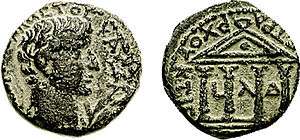Philip the Tetrarch


Philip the Tetrarch, sometimes called Herod Philip II (Greek: Ηρώδης Φίλιππος, Hērōdēs Philippos) by modern writers (ruled from 4 BC until his death in AD 34) was the son of Herod the Great and his fifth wife, Cleopatra of Jerusalem. He was a half-brother of Herod Antipas and Herod Archelaus; and should not be confused with Herod II, whom some writers call Herod Philip I.
Background
Philip inherited the northeast part of his father's kingdom, which included Iturea and Trachonitis;[1] and possibly Gaulanitis and Paneas, as was noted by Flavius Josephus.[2]
Augustus Caesar made his own division of Herod's kingdom, giving one half to Archelaus, while dividing the other half into two, going to Antipas and Philip. Batanea, along with Trachonitis and Auranitis (with a certain part of what was called the House of Zenodorus), paid the annual tribute of one hundred talents to Philip.[3]
Marriage and dynasty
Philip married his niece Salome, the daughter of Herodias and Herod II (sometimes called Herod Philip I,[4] and also a member of the Herodian dynasty). This Salome appears in the Bible in connection with the execution of John the Baptist. The gospels of Matthew and Mark state that the Herodias whom Herod Antipas married was the wife of Antipas' brother "Philip", but according to Josephus she was the wife of another half-brother, Herod II. It is known that Philip the Tetrarch rebuilt the city of Caesarea Philippi, calling it by his own name to distinguish it from the Caesarea on the sea-coast, which was the seat of the Roman government.
Naming convention
There is no contemporary evidence for Philip the Tetrarch's use of the name "Herod Philip" as a dynastic title, as did occur with his brothers Herod Antipas and Herod Archelaus. Herod II is sometimes called "Herod Philip I" (because the gospels call the husband of Herodias "Philip"), and then Philip the Tetrarch is called "Herod Philip II".[5][6] Kokkinos says, "The stubborn existence of many theologians in referring to Herod III as 'Herod Philip' is without any value...No illusory Herod Philip ever existed."[6][p 223-233]; [266] Philip the Tetrarch, "unlike his brothers, did not use Herod as a dynastic name."[7] Philip's half-brothers, Archelaus and Antipas, had adopted the name of Herod, "presumably" for a dynastic claim from Herod the Great.[8]
See also
References
- ↑ As mentioned briefly in the Bible by Luke 3:1
- ↑ Flavius Josephus, Anitquities, 17.8
- ↑ Flavius Josephus, Antiquities, 17.11
- ↑ Flavius Josephus, Antiquities 18.5:4 (137).
- ↑ Note: It is an example of the great difficulty in establishing the relationships of various holders of the same name in the same area or family - especially in the Herodian dynasty.
- 1 2 Kokkinos, Nikkos 'The Herodian Dynasty: Origins, Role in Society and Eclipse', Journal for the Study of the Pseudepigrapha Supplement Series, 1998, Sheffield Academic Press, Sheffield, 236–240
- ↑ Bowman, Alan K., Champlin Edward, and Lintott. Andrew (edd) (2001), Cambridge Ancient History, Vol.10, The Augustan Empire, 43 B.C.-A.D. 69, Cambridge, Cambridge University Press; Refers to him throughout as Philip, or Philip the Tetrarch.
- ↑ Cambridge Ancient History, (latest reprint 1965), Gen. eds.: J.B. Bury, S.A. Cook, F.E. Adcock, M.P. Charlesworth, N.H. Baynes, Cambridge, Cambridge University Press: Vol.10, The Augustan empire, 44 B.C.-A.D. 70
External links
- Philip the Tetrarch entry in historical sourcebook by Mahlon H. Smith
- Herod Philip II biographical entry
| Philip the Tetrarch Died: 34 AD | ||
| Preceded by King Herod I |
Tetrarch of Batanea 4 BC – 34 AD |
Vacant Title next held by King Agrippa I |